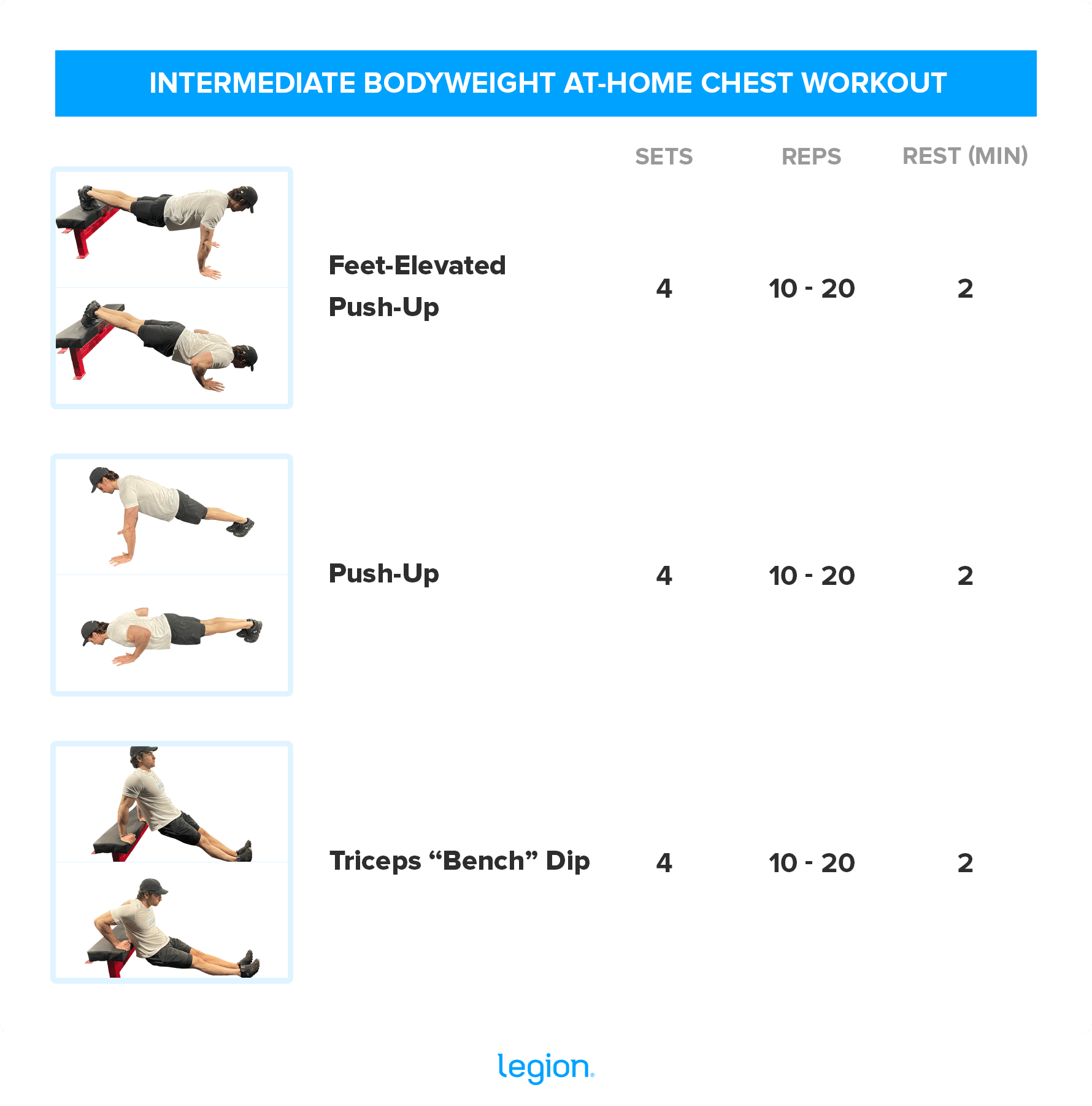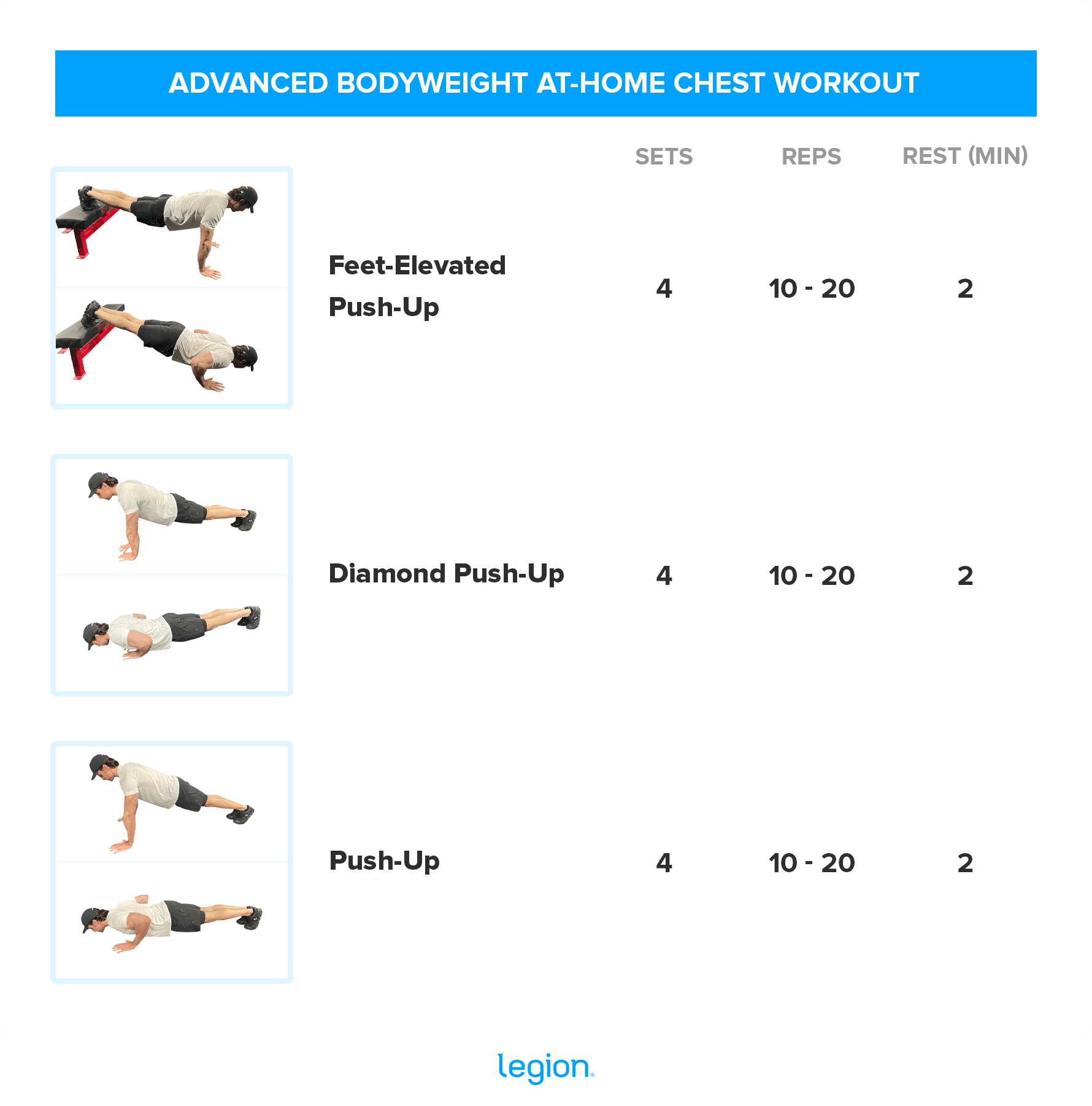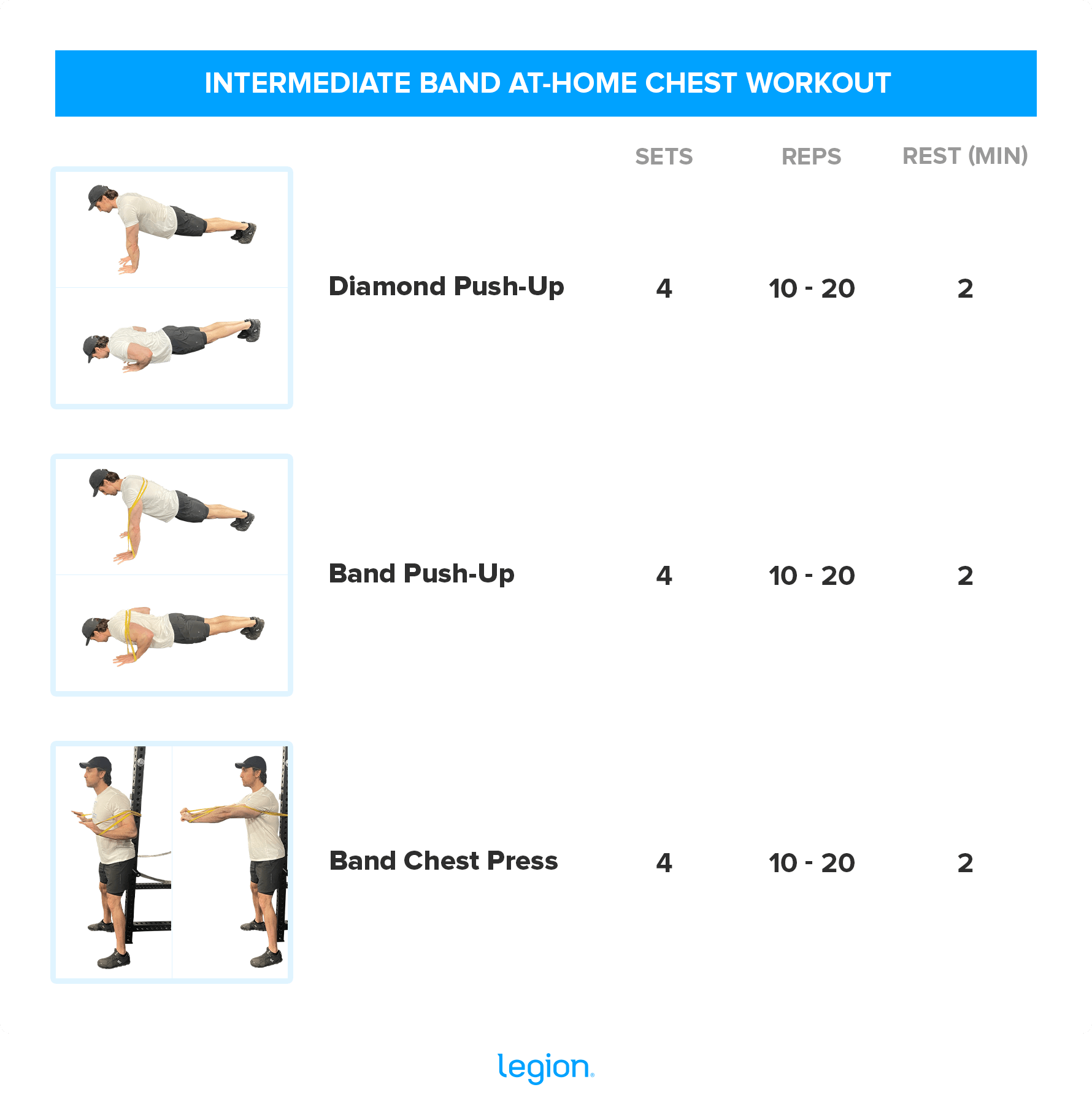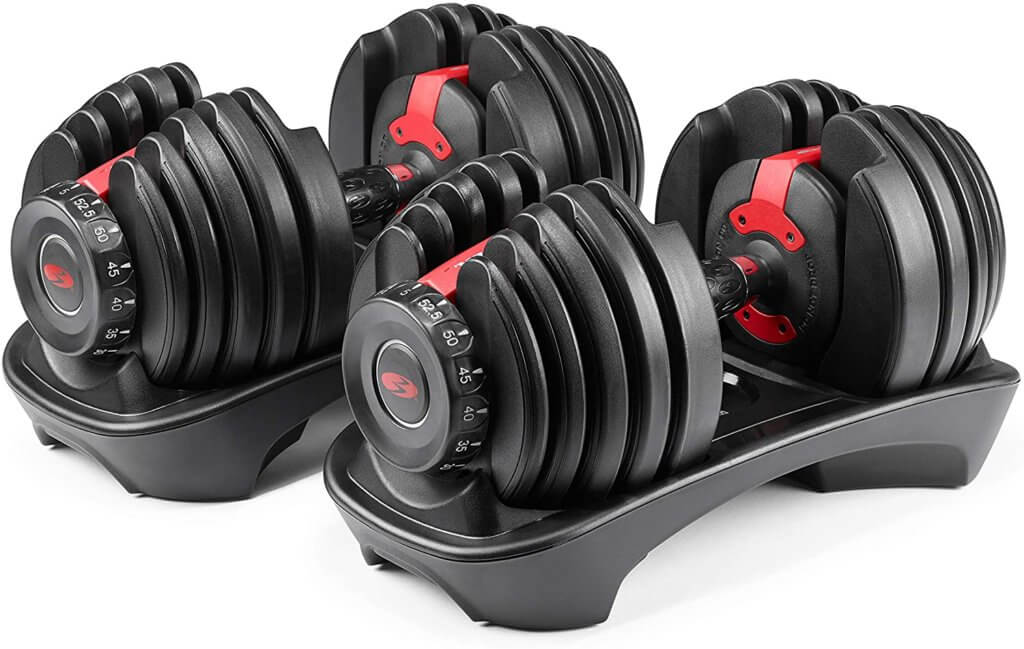
Key Takeaways
- With the right exercise variations, intensity, and (simple) equipment, you can do productive at-home chest workouts.
- If you want to build (or maintain) a powerful and proportionate pair of pecs, you want to use a variety of different at-home chest exercises to train each element of the chest muscles.
- Keep reading to learn the science of effective bodyweight, band, and dumbbell/kettlebell chest training and to get a free at-home chest training program.
Many people who take their fitness seriously think at-home chest workouts are a waste of time.
By their lights, no amount of push-ups, band preses, or bodyweight dips will move the needle, and just a few weeks without barbells and machines will start to wither their precious pecs.
What’s more, they say, even if they were effective, at-home workouts (chest or otherwise) would still get stale faster than a loaf of bread in a hobo’s backpack.
In reality, though, at-home chest workouts don’t have to be fruitless grind.
In fact, research shows that you can gain—or at least maintain—muscle using only bodyweight exercises like push-ups. And if you’re able to get your paws on some bands or dumbbells, you can also retain much of your strength, too.
We’ll break it all down in this article, including . . .
- The science of effective at-home workouts
- The best at-home chest exercises
- The best at-home chest workout routines (with bodyweight, bands, or dumbbells)
- How to progress in your at-home chest workouts
- And more.
Keep reading, and you’ll also get 12 weeks’ worth of free at-home chest workouts, all expertly laid out in Google sheets.
Let’s get started.
The Anatomy of the Chest Muscles
The primary chest muscle is the pectoralis major, or “pec major.” Here’s what it looks like:
Its main function isn’t to press or push away, as many people think, but to bring the upper arm across the body.
As you can see in the image above, the pectoralis major has multiple “heads,” or places where a tendon attaches to the skeleton.
There’s a sternocostal head, which attaches the breastbone and rib cage to your upper arm, and a clavicular head, which attaches your collarbone to your upper arm.
The reason this matters is that how a muscle attaches to the skeleton influences how it responds to various types of training. You can read this article to explore the nitty-gritty details of how this works, but the long story short is this:
If you want to optimally train both heads of your chest muscles and build a proportionate, balanced pair of pecs, you want to use a variety of different at-home chest exercises.
There’s also a pectoralis minor, which is a small muscle that attaches the top of your shoulder blade to your upper ribs, like this:

As you can see, it lies underneath the pectoralis major, and its job is to pull the shoulder blade forward and toward the middle of your chest.
Many of the same exercises that effectively train the pec major also involve the pec minor, so it’s not necessary to use specific exercises for the pec minor (and even if you did, it’d be hard to see whether or not your pec minor was growing).
Summary: If you want to build a powerful and proportionate pair of pecs, you want to use a variety of different at-home chest exercises to train each element of the chest muscles.
The Simple Science of Effective At-Home Chest Workouts
Putting together an effective at-home chest workout is just like putting together any other chest workout, but with more constraints.
By that, I mean you probably won’t have a barbell or bench, a full selection of dumbbells (or any), or machines—the hardware that most chest workout routines call for.
Instead, you have your body and maybe some bands and a limited number of dumbbells or kettlebells, which makes it more difficult to implement progressive tension overload.
Progressive tension overload (aka progressive overload) is the primary driver of muscle and strength gain, and the best way to achieve it is increasing the amount of weight you can push, pull, and squat (getting stronger).
Read: Is Getting Stronger Really the Best Way to Gain Muscle?
The problem with at-home chest workouts is that increasing the weight (implementing progressive overload) can be impractical or even impossible after a certain point.
So, how should you progress in your at-home chest workouts? You have several different options:
1. Do more reps or sets.
Although high-rep sets (usually defined as more than 10 per set) aren’t much fun, research shows they can be just as effective for building and maintaining muscle as lower-rep sets as long as you take them close to muscular failure.
This is only true up to around 20 or 30 reps, however—doing 100 reps to failure isn’t as effective for building muscle as 20 reps to failure, for instance.
Doing more sets can also be an effective strategy for goosing strength and muscle gain—even with bodyweight exercises—but it also quickly hits a point of diminishing returns.
In most cases, there’s little point in doing more than 12 to 15 sets per muscle group per workout or more than 15 to 20 sets per muscle group per week. For most people, exceeding those amounts doesn’t result in more muscle or strength gain and increases the risk of developing a repetitive strain injury (RSI).
2. Use more challenging exercise variations.
- For example, feet-elevated push-ups instead of regular pushups, pull-ups instead of chin-ups, and pistol squats instead of bodyweight squats.
- This can buy you a few more weeks or maybe even months of progress, but you’ll eventually run into the same problems—your workouts won’t be difficult enough to keep gaining muscle and strength.
3. Use bands or dumbbells (if you have access to them).
This is the best option. By using bands or, even better, dumbbells, you can make your workouts significantly more challenging, enjoyable, and productive—enough to continue gaining muscle and strength even without a “real” home gym.
How effective can at-home training really be, though? What’s the best-case scenario?
Well, based on my own at-home training experience, working with thousands of people over the years, and talking with many top researchers and coaches on my podcast, here’s my position:
If you’re a novice weightlifter (a man who hasn’t yet gained his first 20 pounds of muscle and woman who hasn’t yet gained her first 10 pounds, you can effectively gain muscle and strength with at-home workouts. You won’t progress as quickly as you would if you were following a barbell-based training plan, but you’ll get noticeable results.
And if you’re an intermediate or even advanced weightlifter, you can probably maintain most of your muscle and strength with a bodyweight-only workout routine for at least a month or so. If you have bands, you can probably extend this by another month (or possibly more). And if you have a heavy enough set of dumbbells, you can maintain your physique more or less indefinitely (although you’ll likely lose some strength).
I’m a prime example of how effective at-home chest training can be. I used the same kinds of at-home chest workouts you’re going to learn in this article to easily maintain my muscle mass (while losing body fat) when my gym was closed for several months in early 2020.
Case in point:
Alright, with that nerdy know-how out of the way, let’s get to the workouts.
Summary: The best way to gain and maintain muscle and strength with at-home workouts is to get stronger, and the best way to do this is to do more reps and sets, do more challenging exercise variations, and use bands or dumbbells to make your workouts more difficult.
The Legion At-Home Chest Workouts



The Legion Band At-Home Chest Workouts



The Legion Dumbbell/Kettlebell At-Home Chest Workouts



Do two chest workouts per week.
For best results, I recommend doing at least two chest workouts per week separated by at least one day where you don’t train your chest (a rest day or lower body workout day).
For example, you could do your chest workout on Monday, train other muscles groups, do cardio, or rest on Tuesday and Wednesday, then repeat your chest workout again on Thursday.
Here’s an example of what this would look like throughout the week if you were also doing dedicated back and lower-body workouts:

And here’s what this would look like if you only wanted to train three times per week:

End every set one or two reps short of absolute failure.
You don’t need to take every set to the point of absolute muscle failure, but you do have to come close.
You’ll learn to recognize this point the more you work out—it’s when you strain for a rep and feel pretty sure you won’t get the next one.
Rest a minute or two between sets.
You should rest long enough for your breathing and heart rate to settle down, but not so long that you lose your focus.
This will usually be around two minutes for most of your chest exercises.
With that out of the way, let’s go over the equipment you’ll want (or need, for the band and dumbbell/kettlebell workouts) to get the most out of these workouts.
The Best Equipment for At-Home Chest Workouts
If you follow the bodyweight routines, you don’t need any equipment to do your workouts.
As you learned earlier, though, the best way to maintain or gain strength and muscle with at-home workouts is to invest in a few pieces of equipment that allow you to more effectively implement progressive overload.
What’s more, some pieces of equipment make it much easier to do your bodyweight workouts, and are thus also worth buying if you can afford them.
Here are the best ones:
1. Push-Up Handles
The simplest and most cost-effective way to make home chest workouts more challenging is to pick up some push-up handles.
Push-up handles enable you to extend the range of motion of a normal push-up by elevating your hands a few inches off the ground. This is important because research shows that performing exercises through a longer range of motion leads to more muscle growth than performing reps with a shorter range of motion.
Another major benefit of push-up handles is they take the strain off your wrists, enabling you to keep them in a more neutral position throughout the exercise. This is particularly helpful if you plan on doing at-home chest workouts for more than a few weeks, as all those push-ups can beat up your wrists.
These push-up handles from Perfect Fitness are a great option:

2. Resistance Bands
Resistance bands can be used to add resistance to push-ups, to do exercises like banded chest presses or lat pulldowns, and to make your lower-body workouts more challenging, too.
Each band in this set from Draper’s Strength offers a different level of resistance, so as you get stronger, you can make the exercise more difficult by using a thicker band.

Another good option is this set from Fitness Insanity, which comes with comfortable handles and provides 150 pounds of resistance when you use all four bands at once.
3. Dumbbells or Kettlebells
You can train your chest effectively with bodyweight and band exercises, but you’ll make your at-home workouts even more productive with a set of dumbbells or kettlebells.
I use and recommend a set of adjustable dumbbells, like these Bowflex SelectTech 552 Version 2 dumbbells:

The PowerBlock Personal Trainer Set is also a good option, especially if you get the set that goes up to 70 pounds.
As for kettlebells, these ones from Amazon Basics are a good choice.
4. Adjustable Bench
Having a set of adjustable dumbbells or a few kettlebells allows you to do many different chest exercises. If you want to use a greater range of motion or do any kind of incline pressing, though, you’re going to need an adjustable bench.
You can find plenty of cheap adjustable benches out there, but I recommend you invest in something quality. With cheap benches, it’s common for the bolts to come loose, the covering to rip or wear through, and for the wheels to be misaligned.
I recommend the Rogue Adjustable Bench 2.0. It’s a well-built and minimalist bench with wheels and an adjustable seat and backrest—everything you’d want in a quality bench.

If you want a more affordable option, go with the Fitness Reality 1000 Super Max Weight Bench. It’s not as heavy-duty as the Rogue bench, but it’ll fit the bill.
5. Dip Stand
Another relatively inexpensive and handy piece of equipment for making your bodyweight training more effective is a dip stand.
Dips are one of the most effective exercises you can do for building muscle in your entire upper body, particularly your chest. What’s more, if you also get a dip belt, you can incrementally increase the weight you lift by hanging weight plates (or milk jugs, backpacks full of books, and so forth) from your waist.
This dip stand from ProsourceFit is a solid and affordable option:

The Bottom Line on the Best At-Home Chest Workouts
At-home chest workouts using your bodyweight, bands, and dumbbells/kettlebells aren’t as effective as heavy barbell pressing for gaining strength and muscle.
But with the right exercises, workout routine, and attitude (don’t let perfect be the enemy of good and all that), you can maintain or even gain strength and muscle with the workout routines in this article.
So, give the at-home chest workouts in this article a whirl, and don’t let gym closures get in the way of your goal of getting fit.
If you liked this article, please share it on Facebook, Twitter, or wherever you like to hang out online! 🙂
What’s your take on the best at-home chest workouts? Have anything else to share? Let me know in the comments below!
+ Scientific References
- Pinto, R. S., Gomes, N., Radaelli, R., Botton, C. E., Brown, L. E., & Bottaro, M. (2012). Effect of range of motion on muscle strength and thickness. Journal of Strength and Conditioning Research, 26(8), 2140–2145. https://doi.org/10.1519/JSC.0b013e31823a3b15
- Hartmann, H., Wirth, K., Klusemann, M., Dalic, J., Matuschek, C., & Schmidtbleicher, D. (2012). Influence of squatting depth on jumping performance. Journal of Strength and Conditioning Research, 26(12), 3243–3261. https://doi.org/10.1519/JSC.0b013e31824ede62
- Heaselgrave, S. R., Blacker, J., Smeuninx, B., McKendry, J., & Breen, L. (2019). Dose-response relationship of weekly resistance-training volume and frequency on muscular adaptations in trained men. International Journal of Sports Physiology and Performance, 14(3), 360–368. https://doi.org/10.1123/ijspp.2018-0427
- Calatayud, J., Borreani, S., Colado, J. C., Martin, F., Tella, V., & Andersen, L. L. (2015). Bench press and push-up at comparable levels of muscle activity results in similar strength gains. Journal of Strength and Conditioning Research, 29(1), 246–253. https://doi.org/10.1519/JSC.0000000000000589
- Kikuchi, N., & Nakazato, K. (2017). Low-load bench press and push-up induce similar muscle hypertrophy and strength gain. Journal of Exercise Science and Fitness, 15(1), 37–42. https://doi.org/10.1016/j.jesf.2017.06.003
If you enjoyed this article, get weekly updates. It’s free.
Sending…
Great! You’re subscribed.
100% Privacy. We don’t rent or share our email lists.





